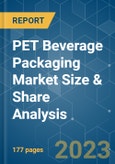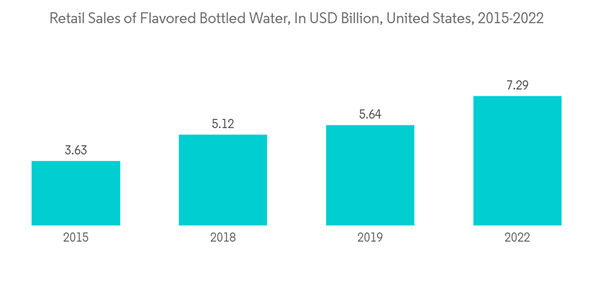The PET Beverage Packaging Market was valued at USD 33.11 billion in the previous year and is expected to grow at a CAGR of 4.67%, reaching USD 43.29 billion by the next five years during the forecast period. Polyethylene terephthalate (PET) is broadening the use of plastic bottles. There is a rising demand for PET packaging in the bottled and soft water segments. Many creative, economical, and environmentally friendly packaging options are already available, and PET is a widely recognized material.
Key Highlights
- The benefits of polyethylene terephthalate as a material are that it is shatterproof, non-reactive when in contact with beverages, and delivers a high strength-to-weight ratio. Being lightweight also provides cost savings when transporting products using PET packaging. PET plastic is a secure packaging material for beverage products. PET plastic has been approved as safe for food and beverage contact by the FDA in the United States and similar regulatory bodies across North America.
- The war between Russia and Ukraine has resulted in economic sanctions against several countries, high commodity prices, and supply chain disruptions. Regarding the conflict, some companies have taken steps to sanction Russia by suspending their activities in Ukraine and other European countries. The Russia-Ukraine conflict has triggered a protest in crude oil and gas markets and a big dose of uncertainty, adding to the already high inflationary pressure on global commodity markets. Several manufacturers also fretted over the transformation in demand from plastics to other raw materials.
- The changing lifestyles and accompanying consumer reliance on packaged beverages boost sales of PET bottle packaging products. This trend is driving the sales of products with their superior barrier properties, convenient formats, high-quality printability, and careful use of material resources. Growing demand for packaged drinking water from consumers worldwide provides higher durability, ease of use, and improved product protection from potential spoilage factors than other packaging alternatives. Due to its low cost, it drives the market for PET bottles for packaging.
- The market is anticipated to be significantly challenged due to dynamic regulatory standard changes, mainly due to rising environmental concerns. Governments globally have been responding to public concerns regarding plastic packaging waste and implementing regulations to reduce environmental waste and improve waste management processes.
- However, manufacturers prefer PET over other packaging products, as it has a minimal loss of raw material during the entire manufacturing process compared to other plastic materials. Its recyclability and the feature of adding multiple colors and designs have made it a suitable choice. Refillable products have emerged with rising consumer awareness about the environment. This has helped in creating the demand for the product.
PET Beverage Packaging Market Trends
Bottles to Hold Major Market Share
- The growing demand for packaged water and carbonated drinks has led to a spike in demand for PET bottles. In addition, increasing environmental awareness and demand for eco-friendly packaging solutions have led consumers to prefer PET bottles over other packaging materials.
- PET offers superior stiffness compared to other plastics. It also maintains a robust protective structure and has moisture resistance. It is used in the production of PET bottles for beverages and liquids. PET is well known because it provides a superior oil barrier that helps resist chemicals that can damage plastics.
- Beverage companies are focused on innovating new solutions. For instance, in line with its goal to transition to 100% recycled and plant-based PET bottles by 2030, the Suntory Group unveiled a prototype PET bottle made from a 100% plant-based materials partnership. The bottle was developed in collaboration with US-based Anellotech for Suntory’s Orangina and Tennensui soft drinks brands in the European and Japanese markets.
- PET is widely favored for plastic bottles (and other uses) because it is 100% recyclable and highly sustainable. It can be recovered and recycled many times into new products, reducing the number of wasted resources. Over the projected period, bio-based plastics, particularly 100% bio-based PET bottles, are anticipated to increase market share.
- As bottled water sales have demonstrated an uptick in recent years, so has per capita consumption in the United States. In the past ten years, annual bottled water purchase has increased by nearly 40%, reaching a total of nearly 47 gallons per person by 2021. Bottled water was the most consumed beverage by Americans a year earlier, followed by soft drinks in second place.
- According to Beverage Marketing Corporation and International Bottled Water Association, the Sales volume of bottled water in the United States has witnessed a steady growth trend. The sale volume shot up to 15.90 gallons in 2022, starting from 13.20 gallons just five years back in 2017. Notably, according to Agriculture and Agri-Food Canada, the retail sales value of flavored bottled water in the United States also increased from USD 3.63 billion in 2015 to USD 7.29 billion in 2022. This growth is expected to be witnessed in the forecast period, also attributing to a substantial push to the market demand for PET water bottles.
Asia Pacific Expected to Witness Significant Growth
- China's packaging industry is growing steadily due to the nation's expanding economy and growing middle class with increased purchasing power. Beverage packaging demand is rising because China's beverage market has grown significantly over the last few years. Each beverage category will face its own set of challenges and opportunities.
- The growing consumption of non-alcoholic drinks in urban regions has propelled the growth of beverages. Such potential has attracted foreign companies like Coca-Cola to continue to invest heavily in the Chinese market. Recently, Coca-Cola China and its bottling partners have announced plans to inaugurate new production lines and a factory, following an estimated total investment of CNY 520 million (USD 75.3 million). Additionally, in 2023, the company invested in its plant to boost its performance and enhance its presence on online and offline channels and marketing innovations. These factors are projected to fuel market growth and attract foreign companies to the Chinese market.
- In India, beverage packaging has witnessed significant growth in recent years. The key factors that drive the market growth include the rapid changes in beverage packaging trends across the country. There has been significant adoption of novel techniques for packaging. New beverage packaging trends focus on the structure modification of packaging materials and the development of new active systems that can interact with the product or its environment, customer acceptability, security, and improving the conservation of several beverages.
- Glass and PET bottles are used extensively in Japan. PET bottles are still chosen over conventional glass bottles because of technical improvements that allow them to perform additional functions besides only retaining liquids. The market for beverage packaging in Japan is driven by the growing consumption of ready-to-drink (RTD) beverages due to busy consumer work schedules and sedentary lifestyles. These bottles help to improve the shelf life and preservation of the products and are available in cost-effective formats.
- The beverage packaging market is expanding significantly due to the growing consumer concerns about the negative health impact of synthetic additives, preservatives, etc., which augment the demand for organic beverages. Additionally, the elevating levels of urbanization and enhanced consumer living standards have propelled the country's per capita expenditures on high-quality, organic drinks.
PET Beverage Packaging Industry Overview
The PET Beverage Packaging market is fragmented with the presence of major players such as Amcor Ltd, Gerresheimer AG, Berry Global Group, Silgan Holdings Inc., and Huhtamaki Oyj. Players are focused on expanding their business by innovating new solutions through collaborations and investments in the industry.- In July 2023 - Amcor Rigid Packaging (ARP) is to partner with Ron Rubin Winery for the launch of BLUE BIN, the first premium wine packaged in a 750mL bottle made from 100% recycled polyethylene terephthalate (rPET) plastic.
- In June 2023 - In Ballito, a coastal town north of Durban, ALPLA is constructing a high-tech recycling plant with a capacity of 35,000 tons of recycled PET material. The plant is ALPLA’s first step in entering the African recycling market and will begin construction in the summer of 2023 with a planned completion date of autumn 2024. ALPLA is investing approximately EUR 60 million (USD 64.5312 million) to strengthen the regional circular economy.
Additional Benefits:
- The market estimate (ME) sheet in Excel format
- 3 months of analyst support
Table of Contents
1 INTRODUCTION
4 MARKET INSIGHTS
5 MARKET DYNAMICS
8 MARKET SEGMENTATION
9 COMPETITIVE LANDSCAPE
Companies Mentioned (Partial List)
A selection of companies mentioned in this report includes, but is not limited to:
- Amcor PLC
- Resilux NV
- Nampak Ltd
- Berry Global Inc.
- Silgan Holdings Inc.
- Graham Packaging
- GTX Hanex Plastic Sp. Z.O.O
- Altium Packaging
- Comar LLC
- Apex Plastics
- Khs GmbH (Salzgitter Klckner-Werke GmbH)
- Esterform Packaging
- ALPLA Group
- Plastipak Holdings Inc.
- Retal Industries Limited
Methodology

LOADING...










